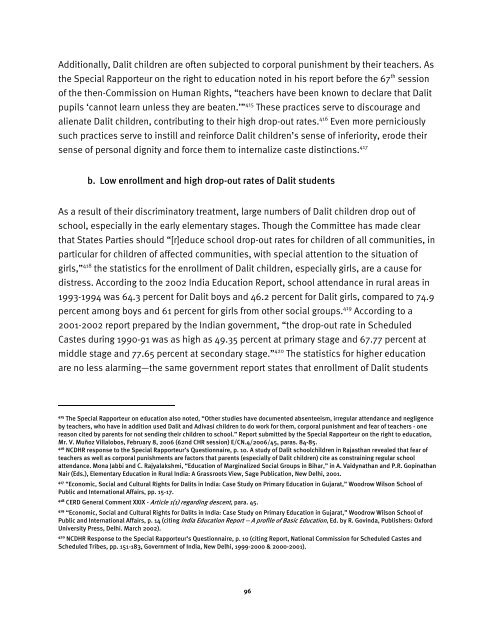Caste Discrimination against India's âUntouchablesâ - Human Rights ...
Caste Discrimination against India's âUntouchablesâ - Human Rights ...
Caste Discrimination against India's âUntouchablesâ - Human Rights ...
You also want an ePaper? Increase the reach of your titles
YUMPU automatically turns print PDFs into web optimized ePapers that Google loves.
Additionally, Dalit children are often subjected to corporal punishment by their teachers. As<br />
the Special Rapporteur on the right to education noted in his report before the 67 th session<br />
of the then-Commission on <strong>Human</strong> <strong>Rights</strong>, “teachers have been known to declare that Dalit<br />
pupils ‘cannot learn unless they are beaten.’” 415 These practices serve to discourage and<br />
alienate Dalit children, contributing to their high drop-out rates. 416 Even more perniciously<br />
such practices serve to instill and reinforce Dalit children’s sense of inferiority, erode their<br />
sense of personal dignity and force them to internalize caste distinctions. 417<br />
b. Low enrollment and high drop-out rates of Dalit students<br />
As a result of their discriminatory treatment, large numbers of Dalit children drop out of<br />
school, especially in the early elementary stages. Though the Committee has made clear<br />
that States Parties should “[r]educe school drop-out rates for children of all communities, in<br />
particular for children of affected communities, with special attention to the situation of<br />
girls,” 418 the statistics for the enrollment of Dalit children, especially girls, are a cause for<br />
distress. According to the 2002 India Education Report, school attendance in rural areas in<br />
1993-1994 was 64.3 percent for Dalit boys and 46.2 percent for Dalit girls, compared to 74.9<br />
percent among boys and 61 percent for girls from other social groups. 419 According to a<br />
2001-2002 report prepared by the Indian government, “the drop-out rate in Scheduled<br />
<strong>Caste</strong>s during 1990-91 was as high as 49.35 percent at primary stage and 67.77 percent at<br />
middle stage and 77.65 percent at secondary stage.” 420 The statistics for higher education<br />
are no less alarming—the same government report states that enrollment of Dalit students<br />
415<br />
The Special Rapporteur on education also noted, “Other studies have documented absenteeism, irregular attendance and negligence<br />
by teachers, who have in addition used Dalit and Adivasi children to do work for them, corporal punishment and fear of teachers - one<br />
reason cited by parents for not sending their children to school.” Report submitted by the Special Rapporteur on the right to education,<br />
Mr. V. Muñoz Villalobos, February 8, 2006 (62nd CHR session) E/CN.4/2006/45, paras. 84-85.<br />
416<br />
NCDHR response to the Special Rapporteur’s Questionnaire, p. 10. A study of Dalit schoolchildren in Rajasthan revealed that fear of<br />
teachers as well as corporal punishments are factors that parents (especially of Dalit children) cite as constraining regular school<br />
attendance. Mona Jabbi and C. Rajyalakshmi, “Education of Marginalized Social Groups in Bihar,” in A. Vaidynathan and P.R. Gopinathan<br />
Nair (Eds.), Elementary Education in Rural India: A Grassroots View, Sage Publication, New Delhi, 2001.<br />
417<br />
“Economic, Social and Cultural <strong>Rights</strong> for Dalits in India: Case Study on Primary Education in Gujarat,” Woodrow Wilson School of<br />
Public and International Affairs, pp. 15-17.<br />
418<br />
CERD General Comment XXIX - Article 1(1) regarding descent, para. 45.<br />
419<br />
“Economic, Social and Cultural <strong>Rights</strong> for Dalits in India: Case Study on Primary Education in Gujarat,” Woodrow Wilson School of<br />
Public and International Affairs, p. 14 (citing India Education Report -- A profile of Basic Education, Ed. by R. Govinda, Publishers: Oxford<br />
University Press, Delhi. March 2002).<br />
420<br />
NCDHR Response to the Special Rapporteur’s Questionnaire, p. 10 (citing Report, National Commission for Scheduled <strong>Caste</strong>s and<br />
Scheduled Tribes, pp. 151-183, Government of India, New Delhi, 1999-2000 & 2000-2001).<br />
96

















